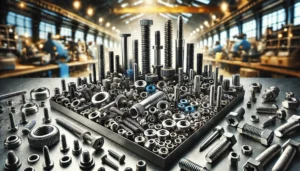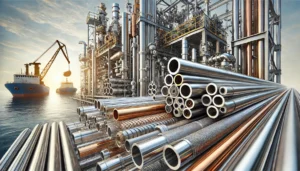Gate valves and globe valves are two types of industrial valves that serve unique purposes in the working zone. These valves are imperative in the industries that utilize them like the oil industry, mining or even power generation. The following are explanations of the two industrial valves.
1. Gate Valves
For controlling the flow of water gate valves are used primarily. As the name suggests a gate valve operates by lifting a gate to allow liquid to flow unfettered to the designated area. A gate valve permits or obstructs water flow by rotating a full 90 degrees. This controller works best when the desired flow is absolutely on or off. Gate valves are highly effective in processes such as gas, water, and oil transmission. A gate valve is also a very economical controller, though it is not useful for flow control as flow regulation through a gate valve leads to excess vibration or damage.
2. Globe Valves
As the name suggests a globe valve is used for throttling and controlling fluid flow in case of pipelines. Unlike canal valves where taps are opened or closed, this globe valve has a movable plug that regulates the position of the water flowing through. Steam pipes, chemical industries, and cooling water plants usually need a defined water flow. The design enables throttling or limiting to control the volume of water.
3. Ball Valves
Ball valves utilize a spherical disc which alters the throttle of a fluid. There is a hole through the middle of a ball allowing fluid to pass when it is facing the right direction, and the flow will cease when the valve is turned ninety degrees. They are mostly used with fluids due to their fast operations. They are often found in devices that require rapid shut off with some pressure dropping like in gas pipes, water distribution systems, and HVAC systems, pipelines.
4. Butterfly Valves
Butterfly valves are composed of a revolving disc placed at the midsection of a pipe. The disc rotates to regulate fluid flow giving a fast and effective means of regulation. These valves are light and small in size which makes them suitable for large pipes, and are mostly found in water treatment plants, HVAC systems, and fire protection systems.
5. Check Valves
Check valves only allow fluid to flow through in one direction to prevent reverse flow which can harm equipment or interfere with processes. These valves operate without manual intervention. Check valves are ultimate for avoiding the reverse flow in the pipelines as they protect pumps and compressors and maintain the system pressure.
6. Pressure Relief Valves
These types of valves pop open to release the excess fluid when a system’s pressure becomes too high. It helps the system prevent injuries and damages caused by overpressure conditions. Every steam boiler, pressure vessel, and gas pipeline utilizes these valves. They are very important in the maintenance of power generating machines.
7. Needle valves
Needle valves are devices that can regulate small amounts of fluids in a pipe thanks to their long, tapered needle design. Needle valves are present in every laboratory, instrumentation system, and gas collection systems which is why they are very common.
8. Plug Valves
Plug valves are responsible for turning the flow to different parts of a system on and off. They are simple in design but provide a reliable shut-off and start flow. These valves are utilized in chemical processing and fuel lines since they can be turned on and off very quickly.
9. Diaphragm Valves
These valves, diaphragm valves, are very useful in pharmaceuticals, food processing and chemical industries as they can control fluid flow using a flexible diaphragm. The diaphragm can also isolate the fluid from the valve which allows the valves to deal with corrosive fluids and very high viscosity liquids with ease. To shut off flow, the diaphragm is pressed against a fluid seat and in order to allow flow, the diaphragm is lifted.
10. Pinch Valves
These valves function by pressing a flexible tube to control slurries, fluids, powders and even granules. Everything is handled with ease due to the extremely simple design of the pinch valves. They are commonly used in places such as wastewater treatment, food processing, and managing extractions in the mining sector.
11. Pressure Reducing Valves
In order to control the fluid pressure, these valves are set to lower the fluid pressure to the required level. They function automatically and adjust themselves to preserve a constant downstream pressure no matter how the upstream pressure fluctuates. They are very important while managing water distribution systems, gas pipelines, and steam systems as they make it possible to protect the equipment and achieve a proper operation.
12. Solenoid Valves
Valves whose operation is electric and regulates the passage of fluid and other materials are solenoid valves. They have a coil, plunger, and valve body that enable automatic control of fluid flow to take place. These valves are often found in sprinklers, automated working machinery, and air conditioning systems.
13. Control Valves
These valves are meant to control the flow, pressure, temperature, and liquid volume of a certain system. These valves are manipulated by a controller who changes the position of the valve to keep the set point constant. In chemical processing, power generation, and water treatment control valves are very important to help in maintaining ideal conditions.
14. Safety Valves
These valves are intended to ensure the safety of individuals and machines by freeing the liquid when the level of pressure gets beyond a permissible value. They are meant to avoid explosions, instrument breakdown in gas pipelines, pressure vessels and boilers.
15. Strainer Valves
These types of valves serve to withdraw fluids and particles from pipelines and protect other administering components from harm. When fluid flows through, the strainer valve captures the particles within the provided mesh filter. Strainer valves are usually found in the water treatment plants, HVAC systems, and chemical processing industries.










